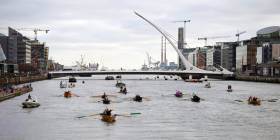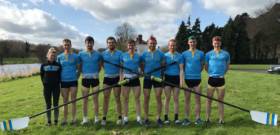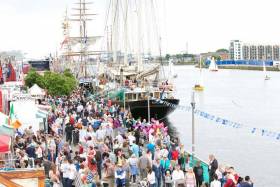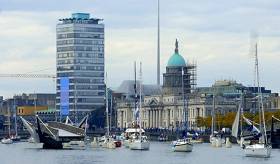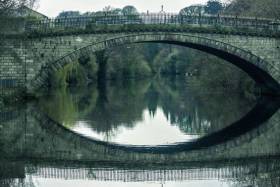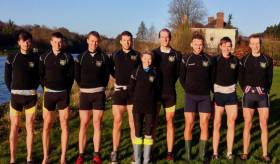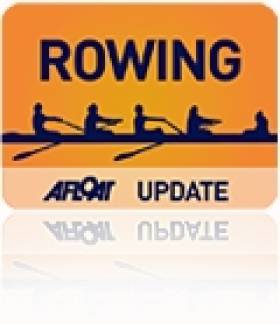Displaying items by tag: liffey
All-in-a-Row Pulls Together Clubs for Charity
#Rowing: The All-in-a-Row charity event on the Liffey drew a flotilla of varied craft to the Liffey in central Dublin today in aid of the RNLI and the Irish Underwater Search and Recovery Unit (IUSRU). There were over 40 boats on the water, and there was a festive air to the outfits of many who guided them.
The IUSRU does the valuable work of recovering bodies of those who have been lost in water. It is a low-profile group which is made up entirely of volunteers. At a reception in the Dublin Docklands building on the Liffey, Richard Kaye of the IUSRU welcomed the funding and boost in profile given by the All-in-a-Row event. Gareth Morrison of the RNLI also expressed his thanks. He spoke of the ambitious plans of the RNLI to cut deaths by drowning. A donation was also made to the St Vincent de Paul, and tribute paid to the men who died on the Kyle Clare, which was sunk in the Bay of Biscay 75 years ago, with the loss of many men, including four from Ringsend.
Wreaths were laid and the Last Post played (by Pat O’Connor of the Communications Workers Union). The reception was attended by the Deputy Lord Mayor, Chris Andrews.
Charities Benefit as Flotilla Takes to Liffey This Saturday
#Rowing: The second annual All-in-a-Row charity event on the River Liffey will be held this Saturday, December 9th. Rowers, kayakers and canoeists will take part in a row or paddle to raise money for the RNLI and The Irish Underwater Search and Recovery Unit. The course runs from the Tom Clarke Bridge (formerly the East Link) to Grattan Bridge, and the event will start at 8 am and end at 3.30. There will be a base at St Patrick’s Rowing Club.
There is a link for those who wish to donate on allinarow.ie.
The RNLI provides a rescue service at sea, along with education and supervision on beaches. It sets out to influence other organisations, policy-makers and regulators, throughout Ireland, England, Scotland and Wales. The RNLI provides a 24-hour search and rescue service to 100 nautical miles out from the coast of Ireland and the UK.
Ninety five per cent of RNLI people are volunteers. RNLI crews and lifeguards have saved over 142,000 lives since the institution was formed in 1824. They have 46 Lifeboat stations around the Republic of Ireland and Northern Ireland and four inland lifeboat stations, at Lough Derg, Lough Ree, Lough Erne and Strangford Lough.
RNLI statistics (2016): 1,136 launches; 1,649 people rescued; 37 lives saved; on average 28 people rescued per week.
The Irish Underwater Search and Recovery Unit (IUSRU) is a charity registered in the Republic of Ireland.
When persons go missing in rivers, canals, lakes or around our coasts they require specialist equipment and personnel to bring them home. The IUSRU is made up of a dedicated team of volunteers who search for missing people underwater and recover them so they can be given a dignified resting place.
The IUSRU was formed in January 2012 to provide a professional, dedicated and highly trained service that could carry out the task of recovering missing persons with compassion and sensitivity.
In 2014 there were 114 recorded deaths through drowning in Ireland.
ThunderCats Belt By Tallship Lined Liffey Quays
#ThunderCats - Thousands of onlookers visiting the Dublin Riverfest watched as ThunderCat powerboats whizzed past tallships lining the North WaII quay, writes Jehan Ashmore.
The thunderboats from the UK that are making their debut in the capital, raced along a circuit that involved making tight turns around the marker buoys. To enjoy this spectacle and much more, the Dublin Riverfest (concluding today) notably features a purpose built spectator stand to watch these small yet fast boats.
On either side of the stand there are also elevated views of the tallships that include a new participant to Dublin Riverfest, the Shtandard, a replica of the Russian warship of Peter the Great dating 1703. The newcomer shares the quay's tallship line of larger tallships.They are a quartet of square-riggers, the Phoenix, Kaskelot, Earl of Pembroke and Pelican of London.
Also entertaining the crowds was the water-jet performer passing the tallships and at close proximity!
Smaller tallships in the form of schooners, in which the UK flagged Bessie Ellen made an appearance having only arrival yesterday afternoon. The West Country schooner moored close to the Irish owned, Brian Boru, a converted Tyrrell built trawler. These vessels however over the weekend were unfortunately not open to the public.
The larger aforementioned Tall Ships though are open to the public and for free. Boaring times (tidal permitting) are between noon and 6pm on this final day of the Riverfest. In total 100,000 visitors are expected to flock the quays that also have food venues, craft stalls, a funfair including a rock-climbing wall and wakeboarding.
Also in port is the Irish ketch, Celtic Mist of the Irish Whale & Dolphin Group, though the vessel is berthed in Grand Canal Dock basin. Tours of the vessel which carries out scientific research cruises on cetaceans are open to the public too.
If travelling by DART, the nearest station that is to the Celtic Mist is the Grand Canal Dock which is only a five-minute walk. The dock basin with its barges, is conveniently located en-route to the Liffey, from where the Samuel Beckett bridge connects to the North Wall.
UCD in Command in Gannon Cup
#Rowing: UCD came out on top in the Gannon Cup for senior men and the Corcoran Cup for senior women on the Liffey today – but in very different races.
Trinity led for most of the Corcoran Cup race, holding off strong UCD pushes. It looked set up for an excellent finish – but then Trinity’s rudder fell off. They had terrible steering difficulties, and UCD powered through to win well.
UCD’s senior men were in command from early on. They made light of their weight disadvantage into the strong, gusting, wind to build a good lead, despite rowing on the South Station, which is less favoured in the early stages.
Trinity won the novice men’s race and UCD the novice women’s.
Colours Races 2017
Men, Senior (Gannon Cup):
UCD (S Bolger, S O’Connell, T Doherty, M Murphy, S Mulvaney, A Griffin, E Gleeson, D O’Malley; cox: O Reid) bt Trinity 3l.
Novice (Dan Quinn Shield): Trinity bt UCD 2l
Women, Senior (Corcoran Cup)
UCD (S Matthews, V Connolly, R Ryan, G Youl, D Callanan, J Coleman, R Gilligan, E Lambe; cox: S Ní Fhinn) bt Trinity easily.
Novice (Sally Moorhead Trophy); UCD bt Trinity easily.
Dublin Port Riverfest Returns This June Bank Holiday
#Riverfest - North Wall Quay will once again play host to the Dublin Port Riverfest this June Bank Holiday weekend.
Tracing the River Liffey from the Ha’penny Bridge in the heart of Dublin City right out through Dublin Port and into Dublin Bay, the capital's maritime festival promises a variety of exciting activities and events.
On-the-water activities will include river ferries and cruises, boat tours of Dublin Port and Dublin Bay, special Try Sailing sessions on both sailing dinghies and keelboats, stand-up paddle boarding (SUP) sessions and kayaking trips.
The Jeanie Johnston will once again be offering free tours over the course of the weekend.
Customs officers will also be on hand all day with their cutter on view, and they will also be carrying out sniffer dog demonstrations.
The jam-packed schedule of displays and entertainment in the festival area includes jet pack displays, sailing races, dragon boat racing, powerboats, pilot displays, international tall ships and more.
Not to be outdone by the water, activities for landlubbers include zip Lines, rock climbing, music and street performances, carnival attractions, face painting and children’s art & circus workshops.
There will be pirate re-enactments all weekend, while Irish Village Markets will deliver an open-air food and craft market.
Dublin Riverfest returns this year from Saturday 3 to Monday 5 June from noon to 6pm daily. The events programme will be added shortly to the festival website HERE.
Cruising Association Of Ireland Has 'Problem Of Success' With Up-Coming Liffey Rally In Dublin
One of last year’s most successful events was September’s Cruising Association of Ireland Rally in Dublin’s River Liffey writes W M Nixon. This involved the varied fleet – many of them much-travelled cruising boats – going in convoy through all the opening bridges as far as the Customs House in a fascinating Saturday afternoon logistics exercise co-ordinated by Dublin Port, Dublin City Council, and the CAI’s John Leahy.
Afterwards, with the fleet berthed at Dublin Port’s then-new pontoon immediately upriver of the Eastlink Bridge at what all true Dubs still think of as the Point Depot, the programme continued across the river with a welcome aboard the German sail training vessel Gorg Foch which was in port on an extended visit. Then the Captain of the Tall Ship with members of his crew joined with the CAI members for a reception aboard the river-berthed Restaurant Ship Cill Airne, followed by a full-house dinner using the Cill Airne’s renowned hospitality services.
The trouble is that when you make such a success of the first attempt at such a challenge, not only do people expect something similar or even better the following year, but as well the key mover and shaker finds that, if anything, he is responsible for even more of the hands-on organisation.
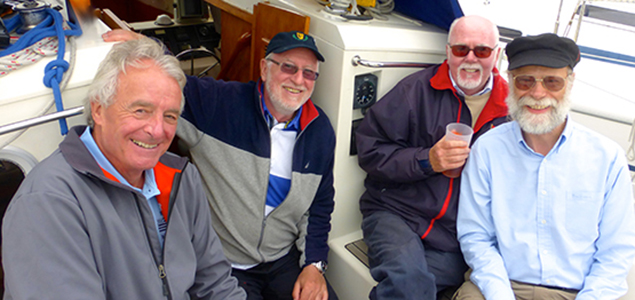 Cruising Association movers and shakers at last year’s Liffey Rally include (left to right) John Leahy, CAI Commodore Clifford Brown, Denis Woods, and Simon Parker. Photo: W M Nixon
Cruising Association movers and shakers at last year’s Liffey Rally include (left to right) John Leahy, CAI Commodore Clifford Brown, Denis Woods, and Simon Parker. Photo: W M Nixon
So as of this morning, John Leahy finds that he already has a full house for the CAI hog roast supper aboard the Cill Airne on the evening of Saturday September 17th to celebrate all that afternoon’s through-bridges manoeuvrings and evolutions. And on top of all that, he is CAI Honorary Secretary, he the Association’s Director of Waterborne Activities, and in recent months he has also found himself in the vital role of CAI Webmaster.
Obviously it’s not a situation which is going to last. But while it exists, you might as well take advantage of it in making instant administrative decisions simply by having an immediate consultation with yourself. So having found that, with just 27 boats booked in, all seating available for the hog roast supper on the ship was thus taken up, didn’t the bould John decide that the supper would start promptly at 7.30pm in order to end neatly within an hour or so, and thereby provide plenty of time for the second part of the evening, a night’s entertainment in the roomier part of the ship. At that convivial gathering, people who had failed to make the cut for the supper could then join the accelerating festivities.
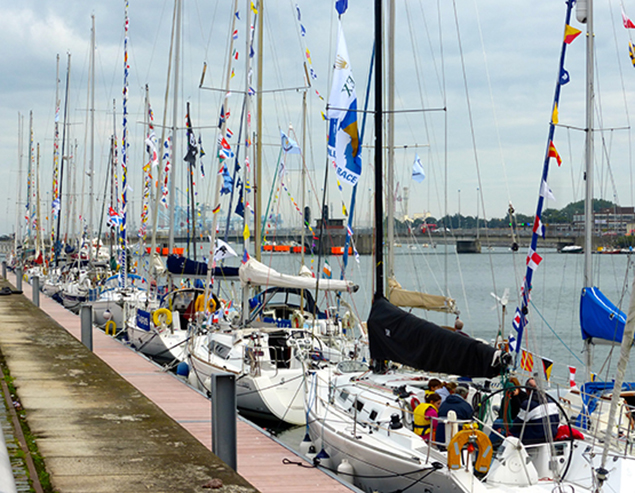 Dublin Port’s pontoon immediately upriver of the Eastlink Bridge can accommodate forty boats with permitted rafting layers. Photo: W M Nixon
Dublin Port’s pontoon immediately upriver of the Eastlink Bridge can accommodate forty boats with permitted rafting layers. Photo: W M Nixon
It’s a situation which arises because the Pontoon Berth above the East Link can actually accommodate 40 boats, and it’s highly likely that up to a dozen additional CAI craft will decide nearer the date that they want to be involved. So the idea is that after the river events and the pontoon-berthed socializing, the extra crews will either have supper on board their own boats or at one of the nearby shoreside hostelries, and then head to the Cill Airne for the main event.
That will include a reception for Dublin Port personnel and Seamus Storan of Dublin City Council, who between them give generously of their time and expertise to ensure that the co-ordination of the bridge openings all runs smoothly. When you think of how rarely you see some of the bridges other than the Eastlink being opened, it gives some idea of how much of a “Once a Year” exercise this has become.
 The CAI fleet in August passing under Thomas Telford’s famous 1826 suspension bridge in the Menai Straits in North Wales. Photo: CAI
The CAI fleet in August passing under Thomas Telford’s famous 1826 suspension bridge in the Menai Straits in North Wales. Photo: CAI
This is proving to be a “Year of the Bridges” for the CAI, as the last time they assembled in significant numbers was at the beginning of August. That was when they had their annual rally to North Wales, an entertaining week which includes transitting the Menai Straits where the two spectacular bridges are at such a height that even the tallest masts can pass comfortably underneath, leaving the boat crews free to enjoy a contemplation of the pioneering engineering involved in the bridges’ construction while also dealing with the renowned tides of the Swellies.
The tides of the Liffey are much more manageable, but nevertheless all signed-up or would-be participants in the CAI Liffey Rally on 17th-18th September 2016 are advised to keep closely in touch with the CAI website.
 The Menai Strait’s Britannia Bridge was also negotiated by the CAI fleet in August. Photo: CAI
The Menai Strait’s Britannia Bridge was also negotiated by the CAI fleet in August. Photo: CAI
Teenager Drowns In Liffey Accident At Islandbridge
#Drowning - Newstalk FM reports that a teenage boy has died after drowning in the River Liffey near Dublin city centre yesterday afternoon (Saturday 14 May).
The body of the 13-year-old boy was recovered by the Garda Water Unit from the stretch of the Liffey between Islandbridge and Chapelizod.
Irish Water Safety has previously warned of the dangers of playing in, on or near the water, noting that 30 children aged 14 and under have drowned in the last decade.
UCD Take Gannon and Corcoran Cups
#Rowing: UCD carried off the Gannon and Corcoran Cups for senior men and women in the Colours races on the Liffey today. In both races, strong starts in the difficult conditions were the key. In the Corcoran Cup, the bigger and more powerful UCD women’s crew had one quarter length by the Ha’penny Bridge, and coming through Capel Street Bridge they extended it to over a length. They went on to win comfortably. The UCD men’s crew also got off the start much more smoothly than Trinity. Trinity mounted a number of attacks down the course, but UCD held them off and won by over a length.
The novice men’s race for the Dan Quinn Shield provided Trinity with a chance to impress, with the crew in white taking command early and having the race won by the Four Courts. The novice women’s race was similarly one-sided, with UCD having only to paddle home after Trinity’s stroke woman caught a crab after only a few seconds of the race.
Colours Races 2016, O’Connell Bridge to St James’s Gate, Saturday:
Men – Senior (Gannon Cup): UCD (E Gleeson, D Somers, T Hughes, A Griffin, E O’Connor, M Murphy, S Mulvaney, D O’Malley; cox: O Reid) bt Trinity 1 1/3 l . Novice (Dan Quinn Shield): Trinity bt UCD, easily.
Women – Senior (Corcoran Cup): UCD (D Callanan, J Coleman, A O’Riordan, E Lambe, O Finnegan, R Gilligan, S Bennett, K O’Connor; cox: J Gilligan) bt Trinity a distance. Novice (Sally Moorhead Trophy): UCD bt Trinity easily.
Cruising Association Brings Dublin’s River Liffey Alive
Many Afloat.ie readers will go into Dublin as a matter of course five days a week as commuters. But that only gives a street-bound and narrow view of the city. It’s a different and fascinating place when you come in up the river. And when the bridges have been specially opened so that you can go all the way into the heart of town on the Liffey right up to the historic Customs House, it’s like a journey through the past with exciting glimpses of what the future may bring as the building industry starts to come back to life. W M Nixon reports on the weekend’s Cruising Association of Ireland Rally, which brought around three dozen boats of all shapes and sizes from many ports together to celebrate friendship, seafaring and the city.
They certainly kept themselves busy with this year’s annual Liffey Cruise of the CAI. With support from the City Council and Dublin Port, Rally Organiser John Leahy had put together a programme which maximised their time in the river, while providing enough opportunities to demonstrate manoeuvring skills in a variety of situations where breakdowns or misjudgements could easily have caused the expensive sound of breaking fibreglass.
It was a wonderful time to be in the city, for although the gentle Autumn day provided only the most occasional little flashes of sunshine, a gentle easterly breeze enabled the more enthusiastic to set gennakers or even spinnakers as they ran along a waterfront which is a bewildering mixture of the new and the half-built and the derelict, while the river itself was alive with kayaks and other small craft, suggesting that at last Dubliners are beginning to appreciate that there’s much more to the Liffey than simply being the separation zone between the civilized northsiders and the barbarous hordes lurking to the south of the watery divide.
On top of all this, the handsome German Tall Ship Gorch Fock was in port for an extended stay, and it had been arranged for the CAI to have their own dedicated and extended visit on board, arranged by Michael Byrne of Sail Training Ireland. As a bonus, close ahead of the Gorch Fock along the South Quays was the large expedition yacht Turmoil, a vessel of fascination in many ways. For she’s perfectly proportioned in the classic style of a trawler yacht, yet when you look at her for a minute it suddenly strikes you that she is actually all of four storeys high - as Jehan Ashmore of this parish pointed out recently, she is in fact as big as the new ships of the Irish Naval Service.
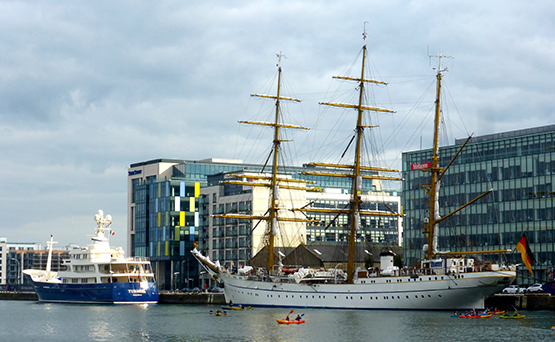
Contrasting styles – the unmistakable Gorch Fock, and ahead of her the workmanlike expedition yacht Turmoil. Photo: W M Nixon
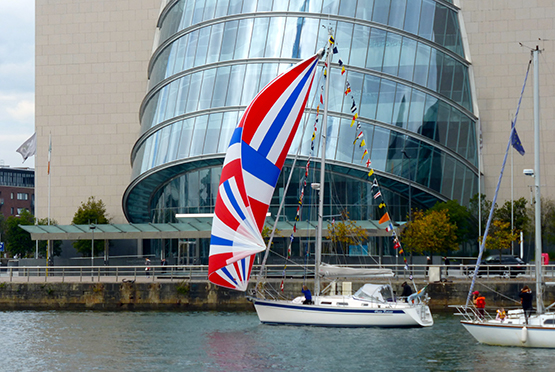
Getting into the spirit of it all – Hair Raiser under downwind sail past the Dublin Conference Centre. Photo: W M Nixon
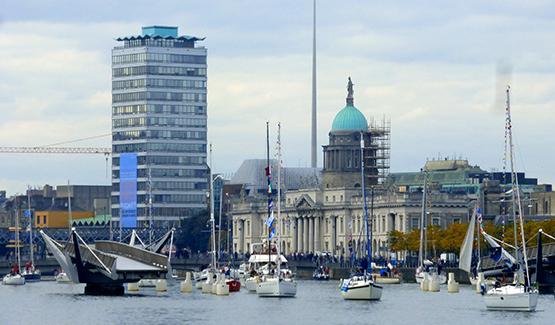
It takes quite a bit of arranging to ensure that a fleet of boats can get this far up the river to the Customs House, where all tastes in architecture are catered for, and there’s the opened Sean O’Casey bridge to negotiate too. Photo: W M Nixon
As it happens, there just wouldn’t have been time to have a proper visit to the Turmoil even if it could have been arranged, as the plan was through the East-Link at 3.0pm and then on past the opened Sam Beckett bridge and the opened Sean O’Casey pedestrian bridge beyond it for a grand circle and salute at the Customs House with an encouraging number of spectators, and then back downriver for rafting up at the pontoon at the Point Depot. It sounds simple enough, but numbers berthing were such that everyone was at least doubled up, and there were many trios.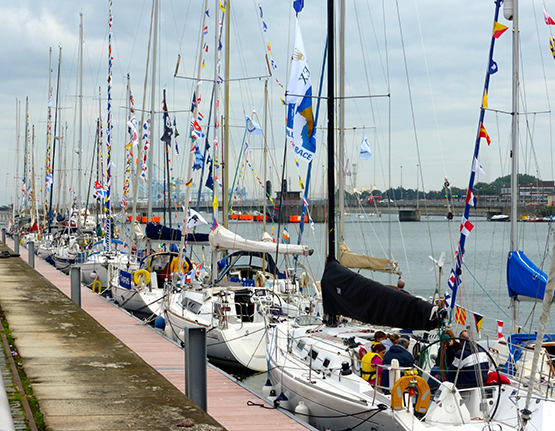
All comfortably and sociably berthed up with never a bother. Photo: W M Nixon
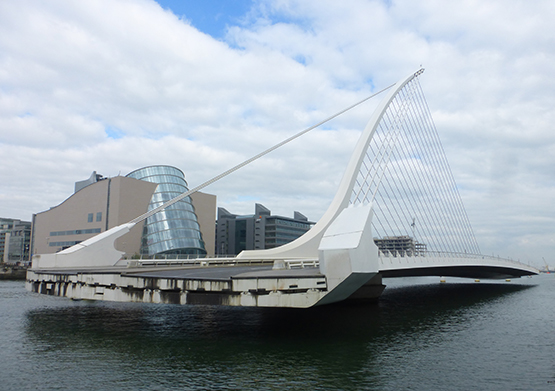 Floating on air? Opening and closing the Sam Beckett Bridge proved to be a real tourist attraction. Photo: W M Nixon
Floating on air? Opening and closing the Sam Beckett Bridge proved to be a real tourist attraction. Photo: W M Nixon
However, it was high water, so the old city was looking its best, while for those watching from the shore, the ultimate attraction was in the closing of the two rotating bridges, the Calatrava-designed Sam Beckett being a particular marvel. It’s a big boy’s toy and then some, and a very international group of visitors to Dublin watched fascinated as this wonderful piece of moving sculpture slipped neatly back into place with great precision.
Meanwhile the fleet had slipped into its places with equal precision, but there was little enough time to relax with inter-boat visits and the usual boat banter, as the programme on the Gorch Fock was to get under way at 5.0pm, so suddenly John Leahy and CAI Commodore Clifford Brown were making themselves scarce with the announcement that they had to get across the river to finalise details with the Captain of the Gorch Foch, which is certainly a fine and important thing to be doing of a Saturday afternoon when half the country is no more than couch potatoes watching a rugby match.
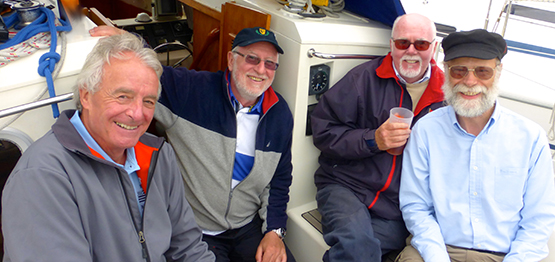
Rally Organiser John Leahy (left) with CAI Commodore Clifford Brown, Denis Woods, and CAI Webmaster Simon Parker. Photo: W M Nixon
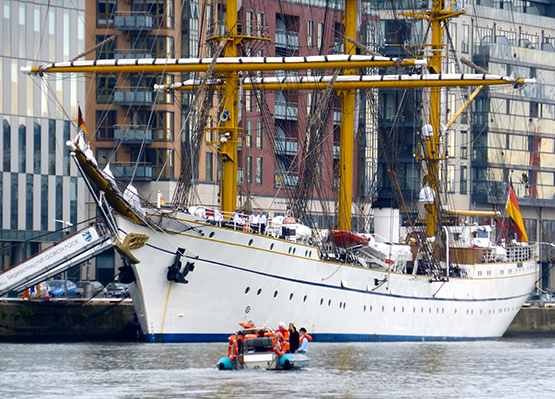
Advance guard. The CAI’s reconnaissance group take a quick lift across the Liffey to finalise arrangements with the Captain of the Gorch Fock. Photo: W M Nixon
Yet as anyone who has walked the quays of Dublin will know, suddenly it will seem a very long and footsore distance to get from the Point Depot round to the Tall Ships’ preferred berth. But the CAI are crazy like foxes - they’d secured the use of a big RIB waterbus, other RIBs were available, and getting across to breathe in the atmosphere of the great age of sail aboard Germany’s finest was an easy and convenient business.
The trouble is when you’re enjoying yourself time flies, and before anyone knew it, time had come to get on the party frocks and get along to the culminating assembly, complete with hog roast, on board the restaurant boat Cill Airne, where Captain Nils Brandt of the Gorch Foch and several of his crew and trainees were their guests.
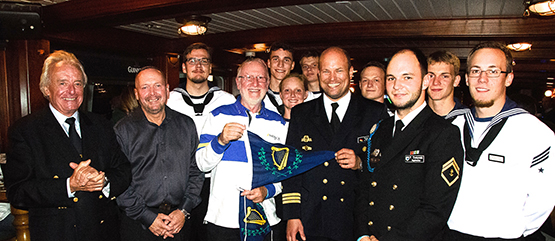
Presentation of CAI flags and ensigns to Captain Nils Brandt and crew of the Gorch Foch by CAI Commodore Cifford Brown with (on left) John Leahy, Rally Organiser, and Charlie Murphy of Dublin Port who organised the many successful river arrangements. Photo: Aidan Coughlan
In all, a busy day, but the weather held up. However, when they took their departure back to sea out through the Eastlink at noon on Sunday, there was rain on the way if it hadn’t already arrived, but there never was any difficult wind, so everyone got neatly home.
And if all this seems like no more than lightly-structured wandering by a group of boats looking for something to do, nothing could be further from the truth. It was a diverse fleet with hundreds of thousands of far-ranging miles under their many keels.
Pat Murphy with his son Shane was there with the much-travelled Aldebaran, and though Pat’s much-loved shipmate Olivia has passed on since the last rally in September 2014, Aldebaran’s gallant presence was an eloquent reminder of the tremendous 9-year voyage round the world they made together. And at the other end of the offshore sailing spectrum, a Rolex Fastnet Race 2015 flag flew proudly from a forestay in the middle of the fleet.
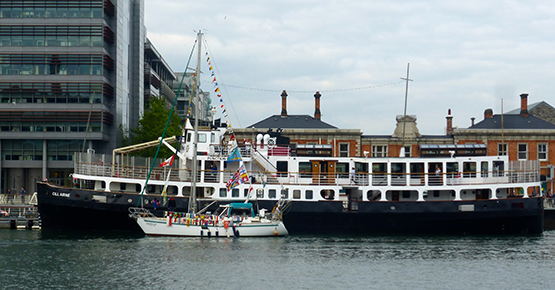
The world-girdling Aldebaran heads up-river past the Cill Airne. Photo: W M Nixon
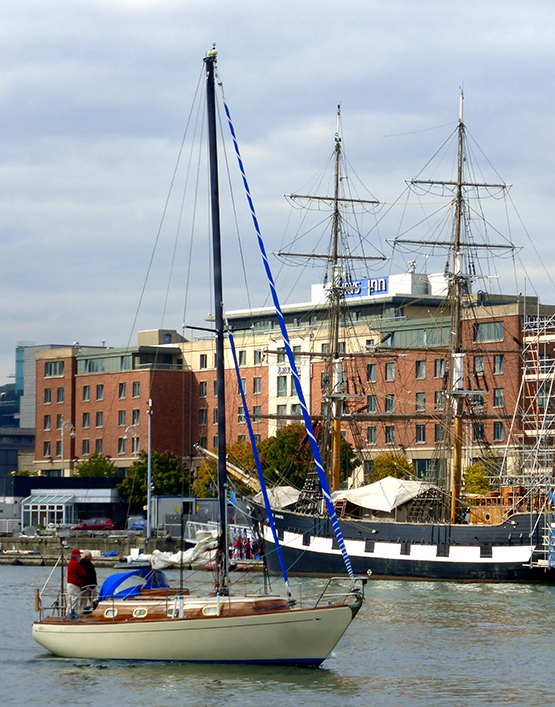
Still looking as good as new. Alan Rountree’s 20-year-old Tallulah, which he completed himself from a bare hull, heads downriver past the Jeanie Johnston. Photo: W M Nixon
Then during the parade in the river, there was the opportunity to admire again the wonderful job Alan Rountree completed twenty years ago when, up at his workshop in the Wicklow Hills, he finished the job of building his Legend 34 Tallulah from a bare hull. He did it so well she still looks like new, despite the fact that he has cruised tens of thousands of miles with her, some to distinctly northern latitudes and remote places, and many single-handed.
So it may have looked like nothing more than a gathering of like-minded yachties in search of a bit of fun. But they’ve certainly earned it, and their celebration of cruising matched their achievements.
Clean Sweep for Trinity over UCD on Liffey
#ROWING: Trinity won all four Colours races on the Liffey today. In the Gannon Cup for senior men, the men in black and white hoops took a small early advantage, stretched it to three-quarters of a length by Capel Street Bridge and won by one-and-a-half lengths. The two novice races were surprisingly one-sided for the Dublin University crews. The best race of the day was the women’s senior contest, for the Corcoran Cup. UCD took an early advantage and led for most of the race. But Trinity were impressively controlled in their rowing and took the lead through the last two bridges. They stretched their advantage to half a length at the finish.
Colours Races 2015, Liffey, Dublin, Saturday, March 14th.
Senior Men (Gannon Cup): Trinity (A Browne, W Doyle, J Magan, M Corcoran, P Moreau, M Kelly, L Hawkes, D Butler; cox: C Flynn) bt UCD 1½ l
Novice (Dan Quinn Shield): Trinity bt UCD, easily
Senior Women (Corcoran Cup): Trinity (G Crowe, H O’Neill, H McCarthy, S Healy, S O’Brien, A Leahy, L McHugh, R Morris; cox: N Williams) bt UCD ½ l
Novice (Sally Moorhead trophy): Trinity bt UCD easily





























